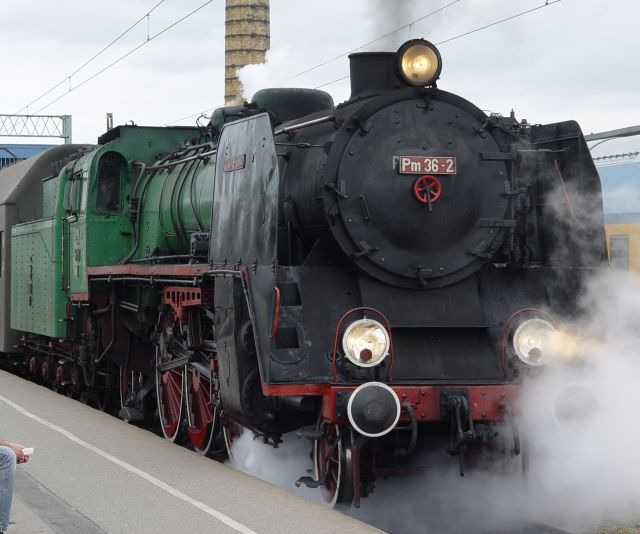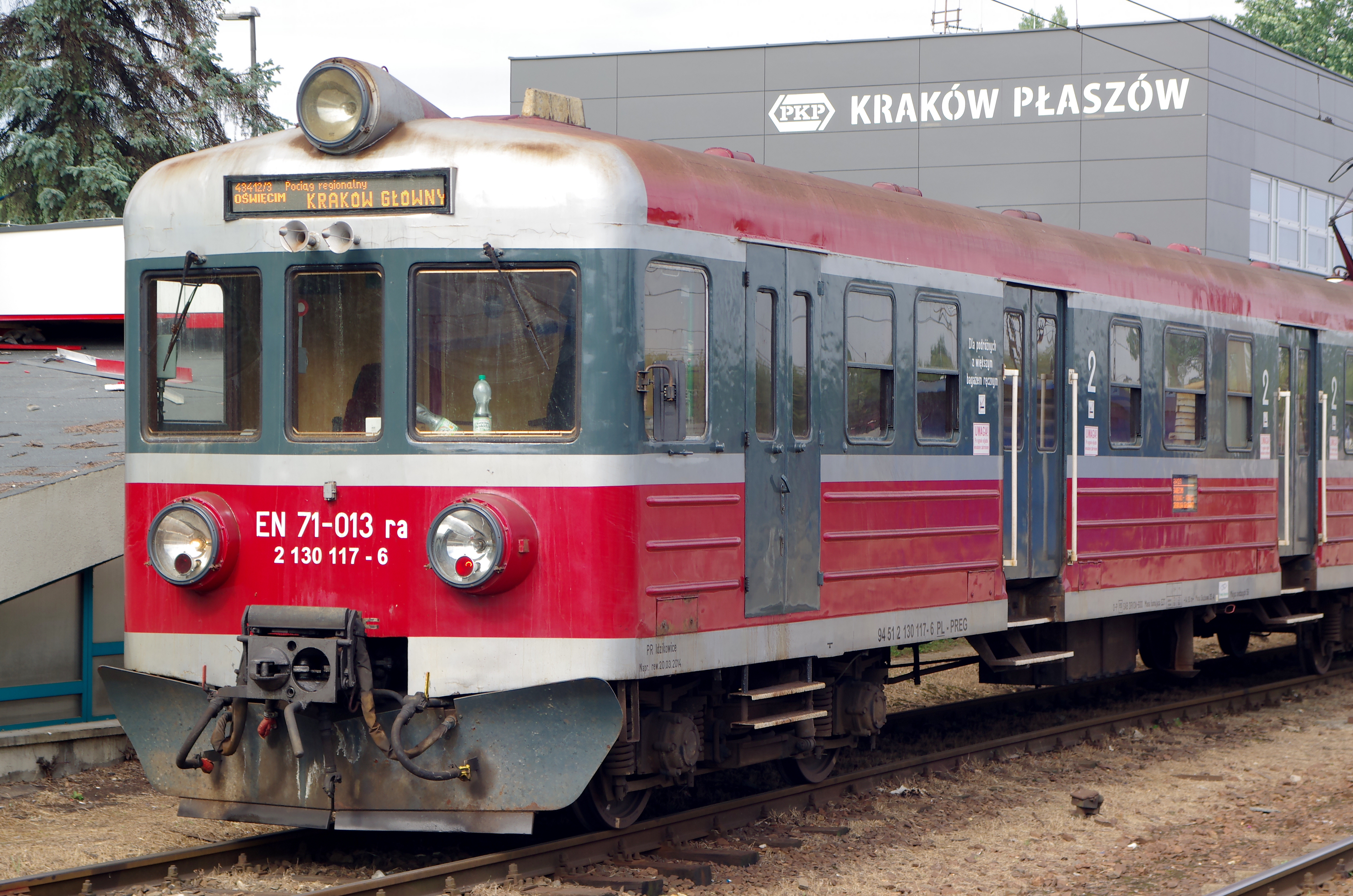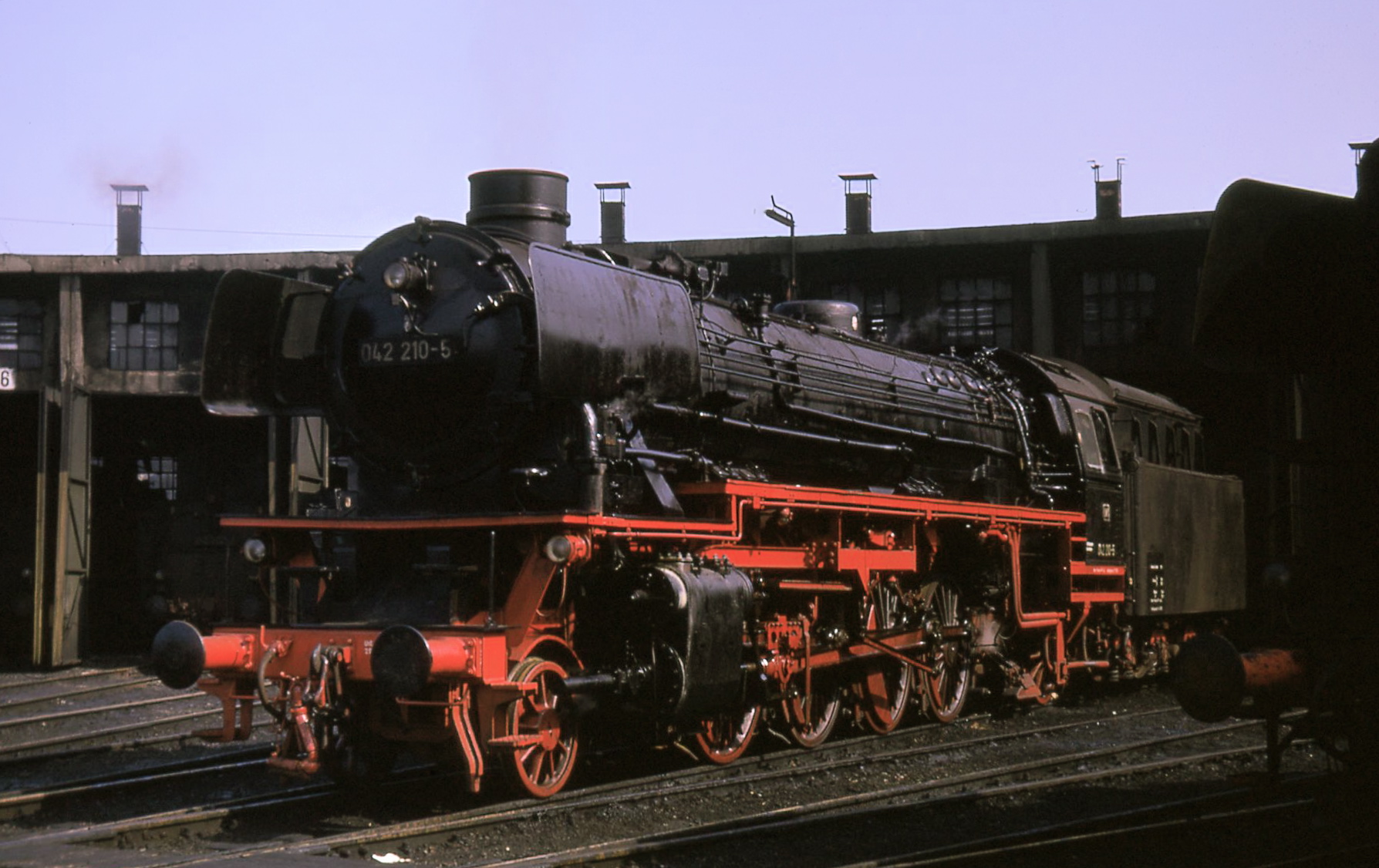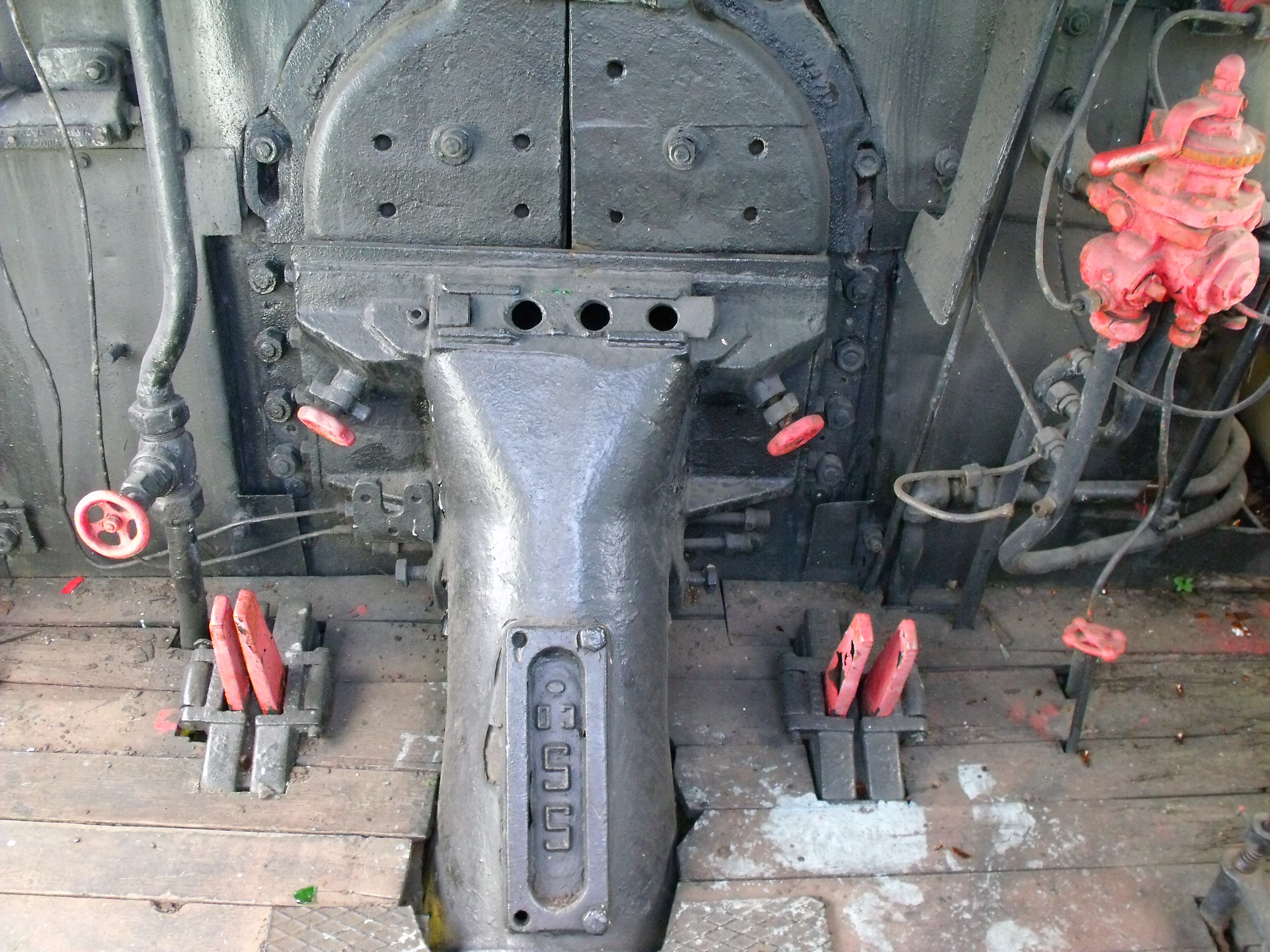|
PKP Class Pt47
PKP Class Pt47 is a Polish steam locomotive. An improvement of the successful pre-war PKP class Pt31 class, the main difference is the addition of circular tubes in the fire chamber, thereby significantly increased boiler performance. This class also featured a superheater and many have mechanical stokers to feed coal into the firebox. 180 locomotives were built in total between 1948 and 1951. The designation stood for fast passenger (P) 2-8-2 (t) locomotive designed in 1947. Although heavy, the Pt47 is powerful and fast. Its main use was to carry heavy fast passenger trains, especially on long distance routes, for example on the difficult route from Cracow to Krynica. They were withdrawn from regular service in 1988. Fifteen survived, mostly in non-working condition. The Pt47 easily reached speeds of , with a heavy train, although is not as refined as the PKP class Pm36 - especially on routes with a lower quality track. A maximum speed of could be achieved even with a train of ... [...More Info...] [...Related Items...] OR: [Wikipedia] [Google] [Baidu] |
Fablok
Fablok is a Polish manufacturer of locomotives, based in Chrzanów. Until 1947 the official name was ''First Factory of Locomotives in Poland Ltd.'' ( pl, Pierwsza Fabryka Lokomotyw w Polsce Sp. Akc.), Fablok being a widely used syllabic abbreviation of ''Fabryka Lokomotyw'', among others as the company's telegraphic address. It is now named "BUMAR - FABLOK S.A. (corporation)". Fablok is located in the town of Chrzanów in Lesser Poland. As of 2009, Fablok no longer builds new locomotives. History Early years 1919-1939 Fablok was established in 1919. A year later a contract was signed with the Polish government to supply 1,200 steam locomotives within ten years to the Polish State Railways (PKP). The first locomotive was delivered on 7 April 1924. In 1931, the first locomotive was exported to the Bulgarian State Railways. During 1935 and 1936, five electric locomotives were built under license from Metropolitan-Vickers. In 1935–1936, Fablok produced five Luxtorpedas (fast ... [...More Info...] [...Related Items...] OR: [Wikipedia] [Google] [Baidu] |
PKP Class Pm36
PKP class Pm36 is a class of two express passenger (P) 4-6-2 (m) steam locomotives ordered in 1936 for the Polskie Koleje Państwowe (Polish State Railways). History Design The design was ready in 1936 and the following year the first two prototypes were built. One of them (Pm36-1) had aerodynamic fairing. The construction as well as the shape of it was designed by inz. Kazimierz Zembrzuski, head of the design office in the First Polish Factory of Locomotives and at the same time professor of the Warsaw University of Technology. The other (Pm36-2) had a standard look. The idea was to test both engines in parallel to compare top speed, acceleration, coal and water consumption etc. The Pm36-1 won a gold medal at the 1937 International Exposition of Art and Technology in Paris. Service After the German occupation of Poland during World War II, the two locomotives were renumbered into the Deutsche Reichsbahn (DRB) fleet as 18 601 and 18 602 (class 186). The 18 601 had its streamlini ... [...More Info...] [...Related Items...] OR: [Wikipedia] [Google] [Baidu] |
Polish State Railways Steam Locomotives
Polish may refer to: * Anything from or related to Poland, a country in Europe * Polish language * Poles Poles,, ; singular masculine: ''Polak'', singular feminine: ''Polka'' or Polish people, are a West Slavic nation and ethnic group, who share a common history, culture, the Polish language and are identified with the country of Poland in C ..., people from Poland or of Polish descent * Polish chicken * Polish brothers (Mark Polish and Michael Polish, born 1970), American twin screenwriters Polish may refer to: * Polishing, the process of creating a smooth and shiny surface by rubbing or chemical action ** French polishing, polishing wood to a high gloss finish * Nail polish * Shoe polish * Polish (screenwriting), improving a script in smaller ways than in a rewrite See also * * * Polonaise (other) {{Disambiguation, surname Language and nationality disambiguation pages ... [...More Info...] [...Related Items...] OR: [Wikipedia] [Google] [Baidu] |
Railway Locomotives Introduced In 1948
Rail transport (also known as train transport) is a means of transport that transfers passengers and goods on wheeled vehicles running on rails, which are incorporated in tracks. In contrast to road transport, where the vehicles run on a prepared flat surface, rail vehicles (rolling stock) are directionally guided by the tracks on which they run. Tracks usually consist of steel rails, installed on sleepers (ties) set in ballast, on which the rolling stock, usually fitted with metal wheels, moves. Other variations are also possible, such as "slab track", in which the rails are fastened to a concrete foundation resting on a prepared subsurface. Rolling stock in a rail transport system generally encounters lower frictional resistance than rubber-tyred road vehicles, so passenger and freight cars (carriages and wagons) can be coupled into longer trains. The operation is carried out by a railway company, providing transport between train stations or freight customer faciliti ... [...More Info...] [...Related Items...] OR: [Wikipedia] [Google] [Baidu] |
Pafawag
Pafawag (Państwowa Fabryka Wagonów) (English: National Rail Carriage Factory) is a Polish locomotive manufacturer based in Wrocław. The company became part of Adtranz in 1997 as Adtranz Pafawag, and in 2001 part of Bombardier Transportation. It is now part of the company Alstom History The factory opened in 1833 as Linke-Hofmann-Werke, Breslau, and became one of the major production centres for rolling stock in Europe. By the end of the Second World War most of the factory had been destroyed, and after the War the city of Breslau became part of Poland. In 1953 the company was renamed Pafawag. In 1953 the company produced the EP-02, the first Polish electric locomotive manufactured after World War II. In the late 1980s to mid 1990s the company experienced increasing economic problems due to lack of orders causing loss of production and lower employment. In 1997 ABB DaimlerBenz Transportation (ADtranz) acquired a majority share in the company. The Adtranz group (Daimler ... [...More Info...] [...Related Items...] OR: [Wikipedia] [Google] [Baidu] |
DRG Class 44
The Class 44 (German: ''Baureihe 44'' or ''BR 44'') was a ten-coupled, heavy goods train steam locomotive built for the Deutsche Reichsbahn as a standard steam engine class (''Einheitsdampflokomotive''). Its sub-class was G 56.20 and it had triple cylinders. It was intended for hauling goods trains of up to on the routes through Germany's hilly regions (''Mittelgebirge'') and up to on steep inclines. They were numbered 44 001-44 1989. History The first 10 examples were built in 1926. These engines had a somewhat higher steam consumption than the first ten units of the DRG Class 43 procured in parallel for comparison purposes, and which were equipped with two cylinders. Not until 1937 were further 44s procured, because by then the rising demands of rail transportation could be better met with a triple-cylinder configuration. From 1926 to 1949, a total of 1,989 locomotives were manufactured. During the Second World War an austerity variant was built with simplified constructio ... [...More Info...] [...Related Items...] OR: [Wikipedia] [Google] [Baidu] |
DRB Class 41
The German Class 41 steam locomotives were standard goods train engines ('' Einheitslokomotiven'') operated by the Deutsche Reichsbahn (DRB) and built from 1937 to 1941. History In the search for a new, fast, goods train locomotive, the Deutsche Reichsbahn-Gesellschaft (DRG) in 1934 was attracted by the proposal from the Berliner Maschinenbau (BMAG, formerly Louis Schwartzkopff) for a 2-8-2 (1'D1'h2) engine. The design, produced by Friedrich Wilhelm Eckhardt (1892–1961), differed from the DRG's original requirement for a 2-8-0 (1'D) engine, because the required performance with an 18-ton axle load was easier to generate on a 2-8-2 engine rather than one with a 2-8-0 wheel configuration. Continued adherence to this instruction would in the end have given the new engine no significant advantage over the Prussian goods train locomotives which were to be withdrawn. The Reichsbahn Central Office Engineering Works (RZM) eventually agreed to this proposal; the BMAG was tasked ... [...More Info...] [...Related Items...] OR: [Wikipedia] [Google] [Baidu] |
Mechanical Stoker
A mechanical stoker is a mechanical system that feeds solid fuel like coal, coke or anthracite into the furnace of a steam boiler. They are common on steam locomotives after 1900 and are also used on ships and power stations. Known now as a spreader stoker they remain in use today especially in furnaces fueled by wood pellets or refuse. There are three types: the over feed, the under feed and the cross feed. The over feed delivers coal on to the top of the coals already in the furnace in the manner of a human working a shovel. The under feeder pushes fresh coal into the bottom of the furnace and then advances it upwards so that it mixes with the burning coal above. The mechanical means used are, depending on design, combinations of the screw feed, the conveyor belt, the bucket chain, the paddle and the ram. Steam jets from the boiler or a mechanical catapult may also be used to throw coal into the far reaches of the furnace. Use in steam locomotives The confined working c ... [...More Info...] [...Related Items...] OR: [Wikipedia] [Google] [Baidu] |
2-8-2
Under the Whyte notation for the classification of steam locomotives, represents the wheel arrangement of two leading wheels on one axle, usually in a leading truck, eight powered and coupled driving wheels on four axles and two trailing wheels on one axle, usually in a trailing truck. This configuration of steam locomotive is most often referred to as a Mikado, frequently shortened to Mike. At times it was also referred to on some railroads in the United States of America as the McAdoo Mikado and, during World War II, the MacArthur. The notation 2-8-2T indicates a tank locomotive of this wheel arrangement, the "T" suffix indicating a locomotive on which the water is carried in tanks mounted on the engine rather than in an attached tender. Overview The 2-8-2 wheel arrangement allowed the locomotive's firebox to be placed behind instead of above the driving wheels, thereby allowing a larger firebox that could be both wide and deep. This supported a greater rate of combustion ... [...More Info...] [...Related Items...] OR: [Wikipedia] [Google] [Baidu] |
Superheater
A superheater is a device used to convert saturated steam or wet steam into superheated steam or dry steam. Superheated steam is used in steam turbines for electricity generation, steam engines, and in processes such as steam reforming. There are three types of superheaters: radiant, convection, and separately fired. A superheater can vary in size from a few tens of feet to several hundred feet (a few metres to some hundred metres). Types * A radiant superheater is placed directly in radiant zone of the combustion chamber near the water wall so as to absorb heat by radiation. * A convection superheater is located in the convective zone of the furnace usually ahead of economizer (in the path of the hot flue gases). These are also called primary superheaters. * A separately fired superheater is a superheater that is placed outside the main boiler, which has its own separate combustion system. This superheater design incorporates additional burners in the area of superheater pipes ... [...More Info...] [...Related Items...] OR: [Wikipedia] [Google] [Baidu] |
PKP Class Pt31
PKP Class Pt31 is a Polish steam locomotive of Polskie Koleje Państwowe, designed for hauling heavy long-distance passenger trains, built in 1932-1940. The designation stood for fast passenger (P) 2-8-2 (t) steam locomotive designed in 1931. The locomotive was entirely Polish design, designed in Fablok in Chrzanów. Polish Ministry of Transport ordered two classes of fast passenger locomotives in Polish factories to compare their merits. Fablok 2-8-2 design was to be named Pt29, but the design was delayed and accepted on in 1931, thus becoming Pt31. Three prototypes were built in 1932 and successfully competed with 4-8-2 Pu29 locomotive - both were similar, but more compact Pt31 better suited Polish turntables. From 1934, a series production for the PKP followed, and by the outbreak of World War II in 1939, 98 were made, numbered Pt31-1 to 98. Further twelve were completed in 1940 under German occupation. Pt31 became the strongest machines hauling long-distance passenger trains i ... [...More Info...] [...Related Items...] OR: [Wikipedia] [Google] [Baidu] |





